Sustainable Battery Components from Rice Hull Ash (RHA)
Prof. Richard M. Laine, University of Michigan, Ann Arbor
14:00-15:00, July 7, 2023
Yiucheng Lecture Hall (500), Xu Zuyao Building
Biography
Professor Rick Laine is a faculty member in both Materials Science and Eng. and Macromolecular Science and Eng. at the University of Michigan. He received his B. S. in chemistry at Cal. State University Northridge followed by a Ph.D. at the University of Southern California. After several postdocs, he spent 11 years at Stanford Research Institute (SRI International) followed by three years in MSE at the University of Washington before coming to UM. His research interests include novel ceramic processing methods and the development of silicon containing polymers for electronic and photonic applications. He has > 300 publications, 45 patents and H factor of 72.
Abstract
To realize a more holistic approach to electrification in society not only is it mandatory that we disengage from non-renewable fuels while adopting new approaches to energy storage, we must realize actual environmental benefits from this transition. Given that the majority of green-house gas emissions in battery value chains originate from material mining and production there is exceptional incentive to find alternate routes to superior lithium ion battery (LIB) com-ponents.
Combustion of rice husks generates 100s of gigawatts of green electricity annually in the U.S. alone and coincidentally ≈150k tons of RHA (90 wt % silica ≈ 10 wt % carbon. We have learned to use RHA to make a number of LIB components including Li+ conducting electrolytes, silicon, silicon carbide and silicon oxynitride anode materials that offer capacities >950 mAh g-1 competitive with porous Si metal.

Upcycling RHA produced coincident with 100s Gigawatts of electricity/yr.
